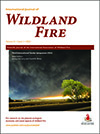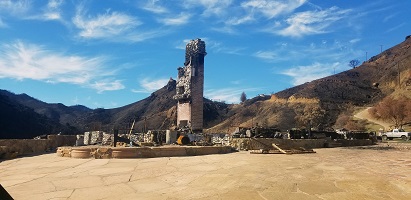Jessica McCarty (Miami University) David R. Weise (USDA Forest Service)

International Journal of Wildland Fire
Volume 31 Number 1 2022
RESEARCH FRONT: Third International Smoke Symposium (ISS3)
Jessica McCarty (Miami University) David R. Weise (USDA Forest Service)
WF20190Projection of future wildfire emissions in western USA under climate change: contributions from changes in wildfire, fuel loading and fuel moisture
Devastating air pollution events from wildfire smoke have increased dramatically in the western United States. Here we indicate that this situation would become worse in the future due to climate change. Increasing fuel amount for burning is an important contributor to increasing fire emissions, in addition to more wildfires.
WF20118Effect of moisture content and fuel type on emissions from vegetation using a steady state combustion apparatus

A small-scale apparatus was used to understand the effect of fuel moisture content (FMC) and type on emissions from vegetation. Smouldering increased smoke production compared with flaming combustion; however, flaming was sensitive to FMC whereas smouldering was not. Differences between fuel species suggests fuel type also plays an important role.
WF20126Application of compositional data analysis to determine the effects of heating mode, moisture status and plant species on pyrolysates
 , Thomas H. Fletcher
, Thomas H. Fletcher  , Mohammad-Saeed Safdari
, Mohammad-Saeed Safdari  , Elham Amini and Javier Palarea-Albaladejo
, Elham Amini and Javier Palarea-Albaladejo 
Compositional data techniques were applied to show that heating mode, plant species and moisture status affected the composition of pyrolysis products in an improved and statistically rigorous analysis. These methods should be used for other compositional data related to wildland fire.
WF21080Roles and experiences of non-governmental organisations in wildfire response and recovery

Non-governmental organisations play critical roles in wildfire relief and recovery. Interviews after three Northern California wildfires reveal changes in NGO mission scope, impacts on mental health, the importance of coordination with government agencies and other NGOs, the value of prior disaster experience, and new challenges posed by the COVID-19 pandemic. Photograph (by Jennifer Gray Thompson) shows the home of Gary and Jean Jones destroyed in the Woolsey Fire. The Jones Family has lived on this land in Malibu Canyon for three decades and endured several wildfire threats, but nothing like the force of the Woolsey megafire event that destroyed their home on 8 November 2018
WF21080 Abstract | WF21080 Full Text | WF21080PDF (211 KB) Open Access Article
Pyrogeography provides a level of generalisation that aids in understanding fire regimes at large spatial scales. This study provides insights into current European pyroregions, which may serve as a basis for wildland fire risk management on a continental scale.
WF21081 Abstract | WF21081 Full Text | WF21081PDF (693 KB) | WF21081Supplementary Material (680 KB) Open Access Article
WF21035Regional drought synchronised historical fires in dry forests of the Montane Cordillera Ecozone, Canada
 , Robert W. Gray and David W. Andison
, Robert W. Gray and David W. Andison
From 1746 to 1945, fires commonly burned in dry forests of the Montane Cordillera Ecozone, Canada, synchronised by regional drought. Moderate-to-highly synchronous fires recurred once per 5.5 years. Post-1945 fire suppression, fuel accumulation and climate change enhanced the size and intensity of synchronous fires in 2017, 2018 and 2021 in British Columbia.
WF21035 Abstract | WF21035 Full Text | WF21035PDF (1.9 MB) | WF21035Corrigendum (1.9 MB) Open Access Article
WF21068An empirical-based model for predicting the forward spread rate of wildfires in eucalypt forests
 , N. Phillip Cheney, James S. Gould, W. Lachlan McCaw, Musa Kilinc and Andrew L. Sullivan
, N. Phillip Cheney, James S. Gould, W. Lachlan McCaw, Musa Kilinc and Andrew L. Sullivan 
We used experimental fire and wildfire data to develop a model aimed at the operational prediction of the rate of fire spread in eucalypt forests. Model evaluation against independent datasets showed good predictive power, with relative errors observed to decrease with increasing rate of fire spread.
WF21068 Abstract | WF21068 Full Text | WF21068PDF (572 KB) | WF21068Supplementary Material (198 KB) Open Access Article



